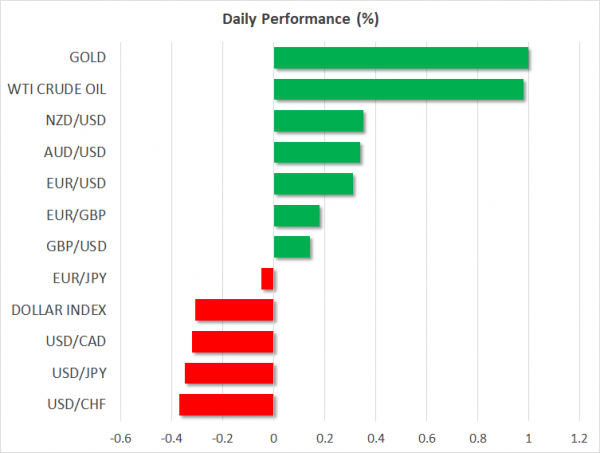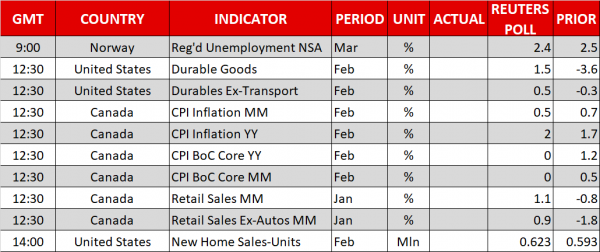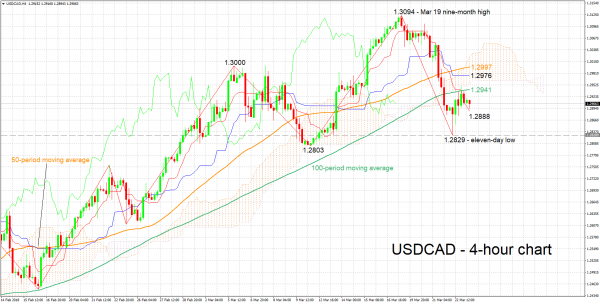Here are the latest developments in global markets:
FOREX: The yen was building on yesterday’s gains versus other major currencies on Friday, as rising fears of a global trade war acted as a catalyst for the currency to attract safe-haven flows. Versus the dollar, the Japanese currency recorded a 16-month high of 104.62.
STOCKS: Equity indices were a sea of red in every region, as the new US tariffs aimed at China reignited concerns that the situation could escalate into a full-blown trade war between the world’s two largest economies. In the US, the Dow Jones led the charge lower yesterday, shedding 2.9% of its value, while the S&P and the Nasdaq Composite plunged by 2.5% and 2.4% respectively. Futures tracking the Dow, S&P, and Nasdaq 100 are all flashing red currently. The carnage was even worse in Asia. In Japan, the Nikkei 225 and the Topix collapsed by 4.5% and 3.6% correspondingly, as the gains in the yen clouded even further the outlook for Japanese exporting firms. In Hong Kong, the Hang Seng tumbled by 2.8% while in China, the CSI 300 dropped by almost 2.9%. Risk aversion looks set to roll into European trading as well, with futures tracking all the major benchmarks being well-into negative territory, signaling a much lower open today.
COMMODITIES: Oil prices surged even despite the broader decline in equity markets. WTI and Brent crude are trading higher by 1.0% and 0.9% respectively. The catalyst for the gains may have been remarks by the Saudi Energy Minister Khalid al-Falih, who noted his country’s willingness to continue coordinating with Russia and other producers in 2019 to rebalance the oil market. Today, attention will fall on the Baker Hughes oil rig count, for an update on the state of US production. In precious metals, gold prices gained 1.0% as risk aversion refueled demand for the safe haven asset. The yellow metal reached a four-week high earlier on Friday, and is currently trading fractionally below the $1340/ounce resistance zone. An intensification in trade risks could see gold extend its gains, and in case of further advances, resistance may be encountered initially at $1350, and subsequently near its recent highs at $1366.
Major movers: Yen on the rise on the back of trade fears
The yen’s perceived safe-haven status allowed it to advance versus other major currencies in an environment of rising trade tensions. At 0730 GMT, dollar/yen was 0.35% down at 104.89, having earlier touched 104.62, its lowest since November 2016. Euro/yen and pound/yen also traded lower, with the former recording a seven-month low of 128.94 at its lowest, though it later pared a considerable part of its earlier losses. Elsewhere and yen-related, Japanese core inflation came in at 1.0% y/y in February as expected. This compares to January’s 0.9% and the Bank of Japan’s target of 2%.
US President Donald Trump signed a presidential memorandum on Thursday targeting tens of billions of dollars of Chinese products with tariffs, though this wouldn’t go into effect right away. Market participants fret a trade war between China and the US, the world’s two largest economies, and expressed their fears by boosting the yen and selling off risk-on assets such as equities. Another safe-haven perceived currency rising versus the dollar is the Swiss franc.
A Chinese response to US tariffs on steel and aluminum products came on Friday, with the country’s commerce ministry saying it was planning measures against up to $3 billion of imports from the US. Should the two countries engage in tit-for-tat retaliatory practices then the equity rout is likely to continue. Meanwhile, Cui Tiankai, the Chinese Ambassador to the United States said “We will retaliate” in a video posted on the embassy’s Facebook page.
Adding to the unstable environment, Trump replaced H.R. McMaster as national security adviser with John Bolton, a known hawk who has in the past supported using military force against North Korea and Iran.
Euro/dollar and pound/dollar were up by 0.3% and by around 0.2%, at 1.2337 and 1.4112 respectively. The Bank of England yesterday completed its meeting on monetary policy keeping rates unchanged, though it was seen as coming closer to delivering a 25bps rate hike in May. As a result, sterling gained versus the dollar and the euro, hitting a one-and-a-half-month high of 1.4216 versus the former before eventually retreating to finish the day lower, and rising to its highest since June last year versus the latter, though it also wasn’t able to sustain gains.
The aussie and the kiwi were up versus their US counterpart, though they were also losing ground versus the yen, falling to near one-and-a-half-year lows. Australia and New Zealand heavily rely on commodity exports and stand to lose substantially should a global trade war emerge.
Finally, it is notable that the Turkish lira took a beating as Japanese retail investors unwound investments in higher-yielding currencies such as the aforementioned. Apart from losing ground versus the yen, the lira also retreated versus other currencies such as the greenback, with dollar/lira at one point rising to a record high of 4.0346. The pair later gave up part of its gains, but it was still up by 1.0% at 3.9710 at the time of writing.
Technical Analysis: USDCAD negative momentum losing steam
USDCAD has lost some ground after reaching a nine-month high of 1.3094 on March 19. The Tenkan- and Kijun-sen lines are negatively aligned in support of a negative bias, though the fact that the Kijun-sen has flatlined hints to a negative momentum that has lost steam.
Upbeat CPI and retails sales numbers out of Canada later today could boost the loonie, pushing USDCAD lower and thus refueling the bearish short-term momentum. Support to declines might come around the current level of the Tenkan-sen at 1.2888 – this was a congested area earlier in March – with a violation turning the focus to the range around Thursday’s 11-day low of 1.2829 for additional support.
Disappointing data on the other hand are likely to lead to gains in USDCAD. The area between 1.2941 and 1.3022, encapsulating the 100-period moving average on the lower bound and the Ichimoku cloud top on the upper bound, while encapsulating the Ichimoku cloud bottom (1.2955), Kijun-sen (1.2976), and the 50-period MA (1.2997) as well, could be of importance, acting a barrier to price advancing.
Developments on the trade front also have the capacity to move the pair.















